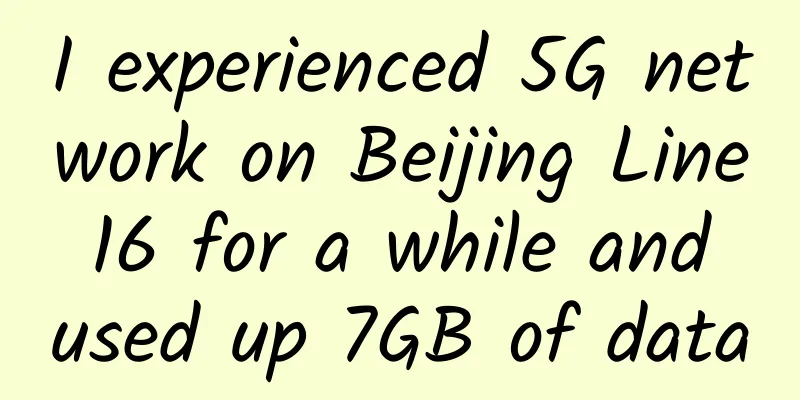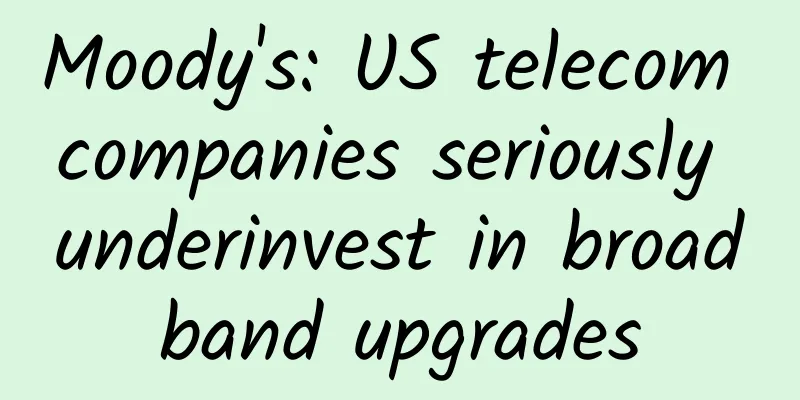I experienced 5G network on Beijing Line 16 for a while and used up 7GB of data

|
What is 5G? Do I need to change my SIM card? Can it be used everywhere now? This is a microcosm of "most ordinary people who don't know much about 5G". For most people, 5G is just a technical term they have heard on the Internet and in the news. It is too high and too vague, and too far away from people's daily activities such as downloading movies, watching TV series, or playing King of Glory. Therefore, people may be more concerned about what the 5G experience is like in the lives of the general public, outside of laboratories or specially built event sites. Beijing's first line fully covered by 5G signals If you want to experience 5G, you must first have the equipment. I use the OPPO Reno 5G version released a few days ago, with a Beijing Mobile 4G card with 5G permissions enabled. For the 5G experience, it can be said that everything is ready except for the east wind. Last week, the "east wind" finally came. Beijing Mobile and Beijing-Hong Kong Metro announced that Beijing Metro Line 16 became the first subway line to be fully covered by 5G network. With the OPPO Reno 5G version of the phone and a SIM card with 5G permissions activated, you can finally experience the 5G network for the first time. There is a reason why China Mobile chose Line 16. Although Line 16 is located in a relatively remote area in Beijing, it is the subway line closest to Houchangcun, the "center of the Internet universe". Near the Xibeiwang subway station on Line 16, there are many large Internet companies such as Sina, Lenovo, NetEase, and Baidu. It can be said that Line 16 is the line with the strongest "Internet flavor". Another reason is that Line 16 is shorter, which can reduce the workload of laying 5G signals. If Line 1 or Line 6, which runs east-west, is covered, the workload may be several times higher. At the same time, Line 16 has fewer people, which makes it convenient for the first batch of 5G terminals to be tested here.
In fact, I went to Beijing Line 16 subway station last weekend to experience it. After consuming more than 7GB of traffic, I had some surprising experiences, but also encountered more problems in use. Generally speaking, I encountered the following problems:
First of all, in terms of signal coverage, Line 16 is said to have full 5G coverage, and in fact the signal coverage is indeed good, even larger, and Line 4, which transfers at the terminus, is also partially covered. Xiyuan Station at the southern end of Line 16 has very stable 5G signal coverage. My plan is to get off the subway every two stations to check the signal coverage. ▲ The signal at Xibeiwang subway station dropped back to 4G In the actual test, I passed through Xiyuan, Xibeiwang, Yongfeng, Daoxianghu Road and other subway stations all the way to Beianhe Station at the northernmost end. Indeed, every station has 5G signal coverage, and the overall coverage of the entire line has been achieved. However, the coverage within the station is not without blind spots, and there have been situations where the signal has fallen back to 4G in some locations. As for when the subway is running, in my observation, although the 5G signal value flickered several times, it did not fall back to 4G.
However, the 5G signal logo on the phone does not mean that the network is smooth. In fact, I encountered several situations where there was a 5G signal but I could not connect to the network or open the web page. There were also situations where I took two steps forward and it would fall back to 4G, and then immediately switch back to 5G when I took the next step. It may be that the 5G technology uses millimeter waves with poor penetration ability, so the coverage boundary is very obvious. This may be the most obvious point I felt during the experience. As my feet moved, the 5G signal and speed measurement showed very obvious fluctuations. I had to walk back and forth like a human detector to find the area with the best 5G signal quality. In places with better 5G signal quality, I experienced a feeling similar to Wi-Fi. Although the delay in the speed test software did not seem to show much advantage compared to 4G, the actual experience did not have the "pause" feeling of 4G. Both Weibo and web pages responded more quickly. As for the download speed, it is a bit disappointing. The speed in most stations and subways is about 30Mbps, and some stations and locations can reach about 80Mbps. Not to mention the speed of more than 900Mbps in the news, even the 4G network can reach or even exceed this level when there are few people. Of course, there is also the possibility that the test card is limited to the maximum speed, so let's look forward to the full-power 5G. ▲ The real-time network speed in the upper left corner reaches 21.8MB/S The highest speed appeared when I was downloading the game "Peace Elite" in a relatively good signal location. It can be seen from the upper left corner of the screenshot that the system's real-time network speed tool showed that the download speed exceeded 20MB/S, which is equivalent to a speed of about 160Mbps, which can basically be regarded as the peak of Line 16. In general, even if you have a 5G mobile phone and phone card, the current user experience on this line alone is not as good as the 4G network. The 4G network not only remains unobstructed at all times, but also performs very stably and reliably, and is not even inferior to the 5G network in speed tests. At the same time, we can also see that 5G networks are not yet mature, but some aspects such as extreme speed still have great potential, and downloading large files will also be more advantageous. We can expect more 5G base stations and signal transmitters to bring a better experience after official commercial use. Let’s talk about 5G after experiencing it After experiencing 5G firsthand, we think there are a few practical issues that need to be discussed. The most important question is: should I switch to a 5G phone now? To answer this question, we need to first figure out what prerequisites are needed to fully experience the 5G network. In fact, before using a 5G phone, you need to make these preparations:
First of all, let's talk about 5G mobile phones. Although 5G networks have not yet been officially commercialized, manufacturers such as OPPO, vivo, Huawei, Xiaomi, and Nubia have launched mobile phones that support 5G networks. However, the prices are staggering. All the models launched by China Unicom are over 10,000 yuan, which is not friendly to consumers at present and still has a strong experimental nature.
So would it be a good idea to buy a 5G phone in the second half of this year and use it for two or three years? I don’t think we need to be so impatient, because the first generation of 5G phones are not mature market products. Not only are they quite large in size, but they also consume more power. After all, external basebands still have certain disadvantages compared to integrated basebands. In addition, since 5G has not yet been officially commercialized, there is still no definite conclusion on aspects including packages and user rights. Whether the packages have more price advantages than 4G and what advantageous application scenarios they have may be issues that consumers are more concerned about, because including equipment replacement is also a considerable expense. ***, 5G network coverage is a major project that takes time to lay. Even though the three major operators have moved very quickly, it is probably impossible to cover most cities with 5G network this year. It would be good enough to cover parts of first-tier cities such as Beijing and Shanghai. Take Beijing Mobile as an example. Although Beijing Mobile and Huawei jointly opened a 5G base station in Beijing's Guomao CBD in December 2018, the Jianwai Soho across the street still showed a 4G network and no 5G signal was found. Obviously, the scope of China Mobile's "Guomao CBD" may be different from what the public perceives. Beijing Mobile further announced that it will cover the Fifth Ring Road with 5G network by the end of 2019. Most netizens expressed doubts about this. Some netizens said that Beijing Unicom's 4G network has not yet fully covered the Fifth Ring Road, which means that Unicom has been faster than China Mobile in laying 5G base stations. China Mobile's claim that it will be able to achieve full 5G coverage within the Fifth Ring Road by the end of the year is probably just empty talk. In addition, due to the characteristics of millimeter waves, the penetration of 5G networks is worse than that of 4G networks, and the coverage range of a base station will be smaller. Therefore, to achieve 4G coverage, more base stations need to be built. Therefore, many beautiful prospects such as high download speeds and extremely low latency need to be based on the mature coverage of 5G networks. Obviously, this will take more time. From the perspective of trying out new things, the 5G network experience will only get better over time based on the current foundation, and judging by the pace of advancement, this time may not be too long. From a practical point of view, 5G devices currently have no cost-effectiveness to speak of. From a personal perspective, 5G network coverage is not progressing as fast as operators say. It is almost impractical to buy 5G mobile phones at present. "This year's 5G mobile phones are only suitable for early adopters. That's all I can say." Shen Yiren summarized this on Weibo three days ago. |
<<: The United States has another big move for 5G: agreeing to merge two major operators
>>: How many devices can a wireless AP and a wireless bridge carry? One article to find out
Recommend
3 common network speed test tools under Linux
No matter what operating system you use, network ...
Three major factors affecting CDN acceleration
With the trend of digital transformation, enterpr...
An article explains what NVMe is
With the emergence of NVMe, the performance of ha...
Forgot your switch password? Don’t panic, here are detailed solutions!
It is said that many people are confused about th...
How much do you know about Zigbee wireless connection?
Zigbee has a wide range of applications and can o...
An article to understand the IPIP network mode of calico
[[397426]] Preface This article mainly analyzes t...
The whole process of solving the problem of sticky packet unpacking during TCP communication
[[359421]] When using TCP protocol for communicat...
200M broadband speed still can't be increased. It turns out that these points are not done correctly.
As early as last year's World Telecommunicati...
[11.11] LOCVPS top up 1000 yuan and get 100 yuan, Hong Kong VPS 30% off, 20% off for all
LOCVPS (Global Cloud) released a promotional plan...
Why are WiFi 6 routers so expensive? Is the technology really that advanced?
We have mentioned the technical content related t...
Ramnode: Cloud server recharge 50% off, promotional VPS hosting from $12/year, Los Angeles/Seattle, etc.
Ramnode also released a promotion during this yea...
What is bandwidth management?
Bandwidth management involves the strategic alloc...
HostXen: DIY cloud hosting available in Hong Kong, the United States, Japan, and Singapore, new user registration with coupons
HostXen is a DIY-configurable cloud server hostin...
CERNET and Shengbang Security have reached a strategic cooperation, allowing colleges and universities to experience more efficient and convenient Web security governance SaaS services
[51CTO.com original article] On October 24, CERNE...
5G in the eyes of Americans
On the first day of the new year, I wrote about R...









